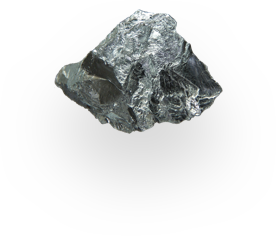- Russian Rhenium project official
- Germanium
Germanium
Germanium, Ge (from the Latin. Germania – Germany* a. Germanium; n. Germanium; f. Germanium; i. Germanio) – a chemical element of the fourth group of the periodic system, atomic number 32, atomic mass 72.59. Natural germanium consists of 4 stable isotopes 70Ge (20.55%), 72Ge (27.37%), 73Ge (7.67%), 74Ge (36.74%) and one radioactive 76Ge (7,67%) with a half-life of 2•106 years. It was discovered in 1886 by the German chemist K. Winkler in the mineral argyrodite; predicted by D. N. Mendeleev (ekasilicon) in 1871.
Physical properties of Germanium
Germanium is a brittle silvery-white metal. It crystallizes in a diamond-type cubic lattice with the period a = 0.56575nm (5.6575 E). Density 5326 kg/m3 (at 25 °С; melting point: 958.5 °С; boiling point: 2690 °С; specific heat capacity (at 0-300 °С) 322.14 J/k•K, thermal conductivity 58.8 J/m•s•K (at 25 °C). The most important characteristics is the semiconducting properties of germanium, the most common natural semiconducting material. Electrical properties (at 25 °C): specific resistivity of single-crystal germanium is 5.6-6.0 kOhm/m, carrier concentration – 2•1013cm-3, bandgap – 0.665 eV, electron mobility mn – 0.39 m2/s, hole mobility mr – 0.19 m2/s.
Chemical properties
Metallic germanium is stable in air at room temperature and burns at temperature above full red heat (600–700 °C) to form a dioxide, solid germanium does not react with nitrogen, hydrogen; liquid germanium interacts with hydrogen at temperature of 1000-1100 °C. The oxidation degree in compounds is +2 and +4; Ge+4 is a stable form. Germanium mono- and dioxides are indifferent, dissolve in alkaline condition to form germanites and germanates. Germanium has many compounds with halogens and sulfur; sulphides dissolve in alkaline solutions to form sulfogermanates, salts in aqua solution are sensitive to hydrolysis producing hydrated dioxide. Ge+4 ionic radius is intermediate between the radii of the ions Si+4 and Ti+4. Most of the germanium oxygen compounds are structural analogues of silicon compounds. Many of them are dimorphic; more dense modifications (for example, GeO2) are similar in structure to titanium compounds.
Germanium in nature
The abundance of germanium in the earth’s crust is (1-2)•10-4%. It is found as an impurity in the minerals of silicon and to a lesser extent in the minerals of iron and zinc. It’s native minerals are very rare: sulfosalts — argyrodite, germanite, rhenierite, and some others; double hydrated oxide of germanium and iron – shtottite; sulphates – itoite, flacherite and some others. They are practically of no industrial value. Germanium is accumulated in hydrothermal and sedimentary processes, where it is possible to separate it from silicon. In increased amounts (0.001-0.1%) it is found in sphalerite, magnetite, hard and brown coal. Sources of germanium are polymetallic ores, mineral coals and some types of volcanogenic-sedimentary deposits of iron ores. The basic amount of germanium is obtained as minor components when processing tar waters during coal-to-coke conversion, from ashes of forge coal, sphalerite and magnetite concentrates. Germanium is extracted by acid leaching, sublimation in reducing environment, alloyage with the sodium hydrate, etc. Germanium concentrates are treated with hydrochloric acid when heated, the condensate is refined and subjected to hydrolytic decomposition to form a dioxide; the latter is reduced by hydrogen to metallic germanium, which is refined by fractional and directional crystallization, zone refining.
Germanium use
Germanium is used in radioelectronics and electric engineering as a semiconductor material to manufacture diodes and transistors. Germanium is used to produce lenses for IR optics, photodiodes, photoresistors, nuclear radiation dosimeters, X-ray spectrum analyzers, converters of radioactive decay energy into electrical power, etc. Alloys of germanium with some metals (characterized by increased resistance to acidic aggressive environment) are used in instrument engineering, mechanic engineering and metallurgy. Some alloys of germanium with other chemical elements are superconductors.



